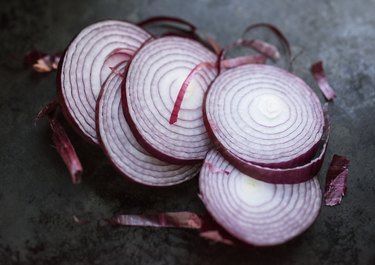
Purple onions, also called red onions, offer a healthy way to give your meals more flavor and provide nutrients without adding many calories. They also provide phytochemicals — beneficial plant chemicals — that may help lower your risk for certain health problems.
The research is still preliminary, however, and it isn't clear just how much onion you need in order to experience these potential benefits. But here's what we do know about the nutrition facts and health benefits of purple onions.
Video of the Day
Video of the Day
Basic Nutrition Facts
A 100-gram portion (about half an onion) of red onion has 44 calories, according to USDA. A whole onion (194 grams) contains almost no fat (0.1 gram) and just under 1 gram of protein. They are primarily a carbohydrate-based food (a medium onion has 10 grams of carbs).
However, a small onion also provides 9 percent of the daily value for vitamin C, which you need for forming collagen and healing wounds, and 5 percent of the daily value for manganese, a mineral essential for proper bone development and metabolism.
Phytochemical Content
Purple onions get their color from beneficial plant chemicals called anthocyanins. They also provide you with quercetin and sulfur, which is responsible for the smell of the onion, its flavor and the tears people often experience when cutting onions. Anthocyanins are antioxidants that help prevent cell damage, keep your heart healthy and may lower your risk for cancer.
Quercetin acts as an antioxidant and an anti-inflammatory, helping limit your risk for cancer and heart disease. The sulfur compounds found in onions may help lower your risk for cancer by minimizing the growth and spread of tumors, according to a June 2017 study in Food Research International.
Potential Health Benefits
Eating red onion may help lower your blood sugar, according to an October 2010 study in Environmental Health Insights. In this study, diabetics' fasting blood sugar levels were tested four hours after eating a 100-gram serving, or about three large slices, and found to have decreased significantly.
And an October 2010 article in the Journal of the Korean Society of Food Science and Nutrition states that eating onions may help improve other heart disease risk factors, but further research is needed to confirm these potential benefits.
Tips and Ideas for Eating Onions
If you're using onions raw, as they are often eaten, rinse the onions after you chop them to improve their flavor. For cooked onions, the more finely you chop the onions, the stronger their flavor will be.
You can pickle red onions and add them to sandwiches or serve them as a side dish, use them raw in salads and salsas or top a pizza with them and other vegetables. Red onions can be used in place of white or yellow onions in most recipes.
- Environmental Health Insights: 'Preliminary Study of the Clinical Hypoglycemic Effects of Allium cepa (Red Onion) in Type 1 and Type 2 Diabetic Patients'
- Plant Foods for Human Nutrition: 'Dietary Onion Intake as Part of a Typical High Fat Diet Improves Indices of Cardiovascular Health Using the Mixed Sex Pig Model'
- Phytotherapy Research: 'Onions -- a Global Benefit to Health'
- Office of Dietary Supplements: 'Manganese'
- Office of Dietary Supplements: 'Vitamin C'
- Food and Nutrition Research: 'Anthocyanidins and anthocyanins: colored pigments as food, pharmaceutical ingredients, and the potential health benefits'
- Nutrients: 'Quercetin, Inflammation and Immunity'
- Food Research International: 'Antiproliferative activity of Ontario grown onions against colorectal adenocarcinoma cells'
Was this article helpful?
150 Characters Max
0/150
Thank you for sharing!
Thank you for your feedback!